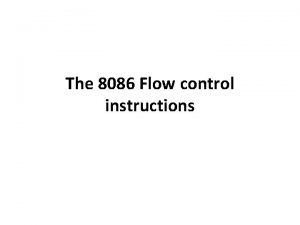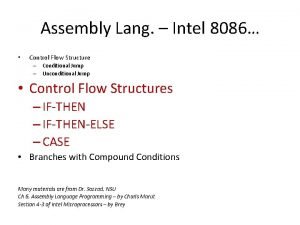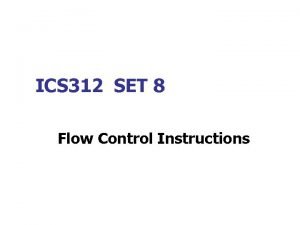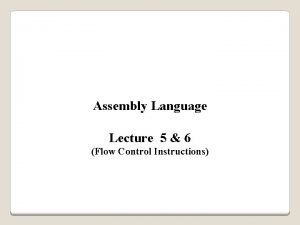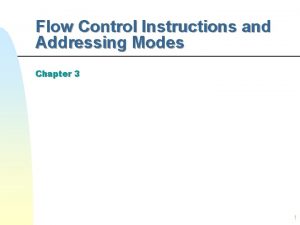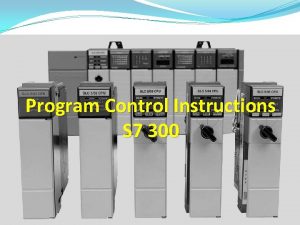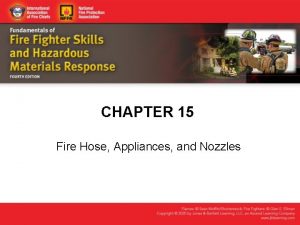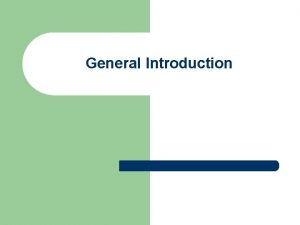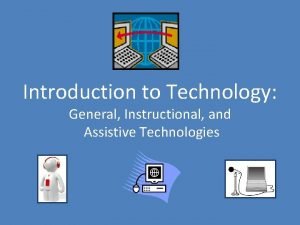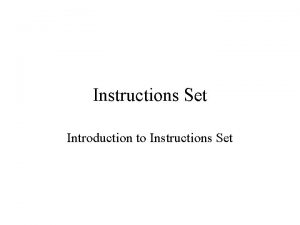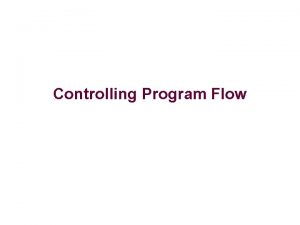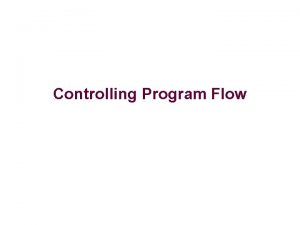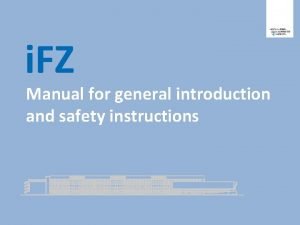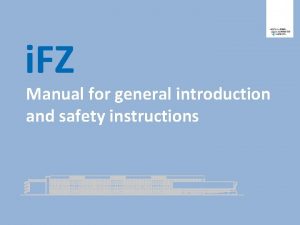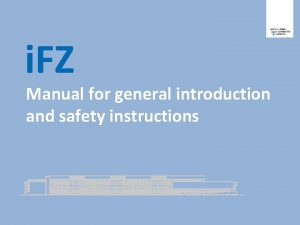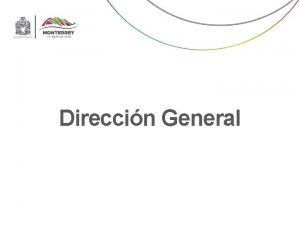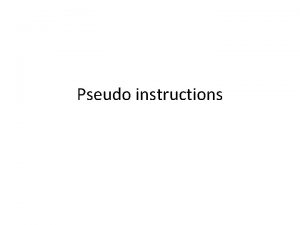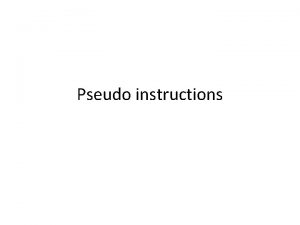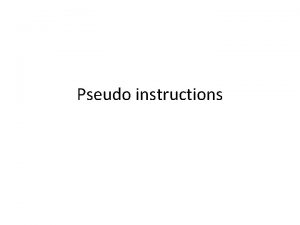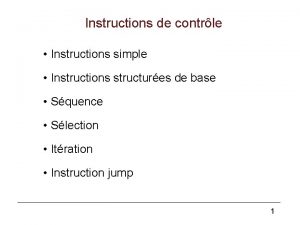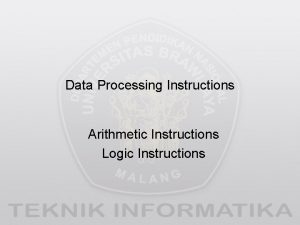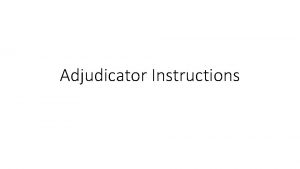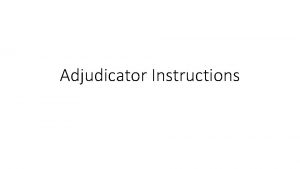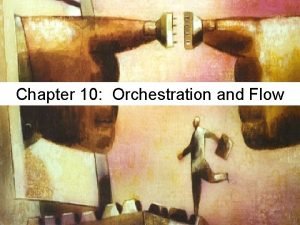Program Flow Instructions General Introduction Program flow instructions




















- Slides: 20

Program Flow Instructions

General Introduction • Program flow instructions modify the value of PC upon execution. • Divided in two groups: – Subroutine instructions: call, return from interrupt – Jump or branch instructions: Conditional and unconditional jumps

Program Flow: Subroutine Instructions CALL and RETURN

Subroutines and Procedures • Subroutines (also called functions or procedures) are pieces of executable code written and stored apart from the main code • They are to be executed when invoked from main code or other subroutine, but flow must return to original “normal” flow • Subroutine may be located anywhere in the source, before or after main code.

Instructions: Call and Return • call dest: Pushes PC and loads PC with dest, – Addressing modes apply to dest • ret : pops PC

Subroutine process 1. Just before CALL execution PC points to next memory location after CALL. 2. Upon execution, the content of PC is pushed onto stack, and PC loaded with address of subroutine entry line 3. Subroutine is executed until instruction RET (return) is found. 4. Execution of RET pops PC, restoring the address of the instruction just after CALL Important remark: Subroutine must be designed so that when RET is encountered SP is pointing to the right location --- This happens every time CALL is executed

Program Flow: Jumps

General Concepts • Jumps simply change the flow, without implying any return. • Unconditional jumps change the value of PC. • Conditional jumps change the value of PC only when certain flag conditions are met – Normally, a conditional jump is preceded by one instruction affecting flags. • Jumps are limited in memory space, microcontroller dependent – MSP 430 jumps are limited within +- 1024 spaces

General Concepts (2) • Conditional jumps are used to emulate control structures of the type, IF-THEN, IF-ELSE-THEN, FOR LOOPS, WHILE LOOPS, etc. • A conditional jump test if a flag or a relation among flags is set or not set.

Principle governign Conditional Jump and the Control Structures (cont) • Single Flag(s) condition Instruction affecting flags Yes FLAG? No • Multiple Flags: FLAG_A AND FLAG_B Instruction affecting flags FLAG_A? • Multiple Flags: FLAG_A OR FLAG_B Instruction affecting flags No Yes Yes FLAG_B? FLAG_A? No No Yes FLAG_B? No

Unconditional Jump and the Branch Instruction • jmp label: loads PC with label • br dest: branch to dest, is the same that mov dest, PC.

Basic conditional jumps (Not all present in all CPU’s) • • jz: jump if zero (jumps if Z=1) ** (in MSP 430) jnz: jump if not zero (jumps if Z=0) ** jc: jump if carry (jumps if C=1)** jnc: jump if no carry (jumps if C=0)** jv: jump if overflow (jumps if V=1) jnv: jump if no overflow (jumps if V=0) jn: jump if negative (jumps if N=1)** jp: jump if not negative (jumps if N=0)

Conditional Jump (cont): Other mnemonics and jumps These are used when comparing numbers jeq: jump if equal (= jz ) jne: jump if not equal (= jnz ) jhs: jump if higher or same, for unsigned numbers (= jc) jlo: jump if lower, for unsigned numbers (= jnc) jge: jump if greater or equal, for signed numbers (jumps if N=V)** • jl: jump if less, for signed numbers (jumps if N V) • • •

Conditional and loop structurs Code structure

IF-THEN

IF_ELSE

FOR-LOOPS

WHILE LOOP

REPEAT-UNTIL LOOP

Examples: Delay loop and iteration loop Example: mov #delay, R 15 Del. Loop: dec R 15 jnz Del. Loop Example: Extended delay loop mov #delay, R 15 Del. Loop: nop dec R 15 jnz Del. Loop
 Cmp instruction in 8086 example
Cmp instruction in 8086 example Assembly language programming
Assembly language programming Flow control instructions
Flow control instructions Assembly absolute value
Assembly absolute value Sequential control flow instructions
Sequential control flow instructions Planos en cinematografia
Planos en cinematografia Where did general lee surrender to general grant?
Where did general lee surrender to general grant? Program control instructions in plc
Program control instructions in plc Fire hose appliances and nozzles
Fire hose appliances and nozzles General ledger process flow
General ledger process flow Introduction to general phonetics and phonology
Introduction to general phonetics and phonology General insurance introduction
General insurance introduction General introduction
General introduction Introduction about technology in general
Introduction about technology in general Gimp gnu image manipulation program meaning
Gimp gnu image manipulation program meaning Emergency nursing orientation
Emergency nursing orientation Richa jain md
Richa jain md Cylinder oxygen
Cylinder oxygen Fraction of inspired oxygen
Fraction of inspired oxygen Turbulent flow
Turbulent flow Internal flow vs external flow
Internal flow vs external flow
